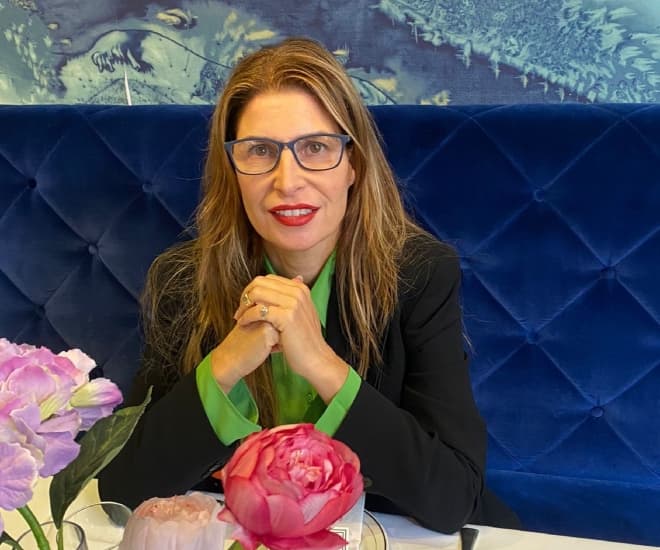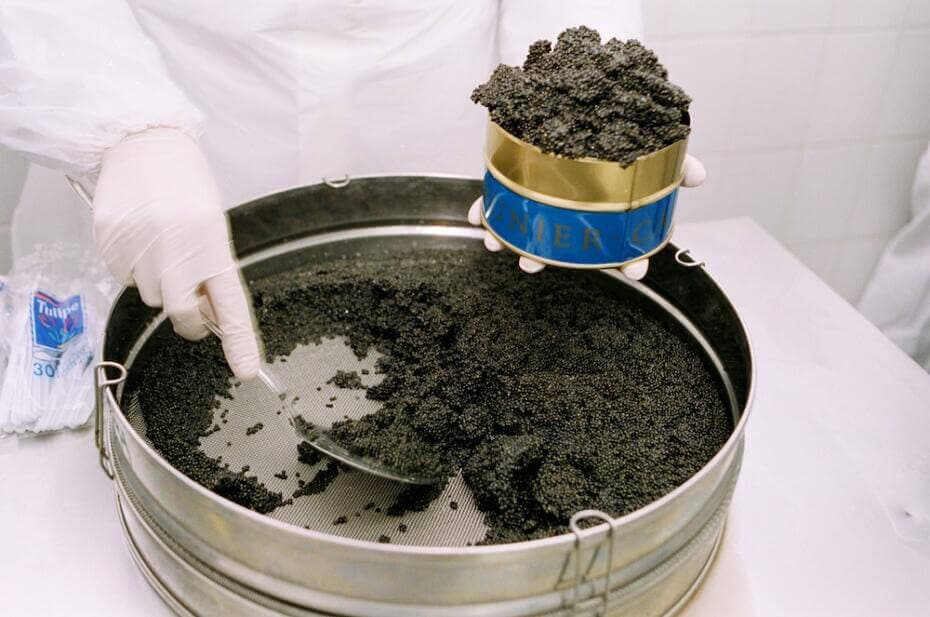
Playfully known as “The Caviar Queen”, Natalie Rebeiz, COO of Caviar House, was born into a family of caviar pioneers; her late father Georges Rebeiz, famous for founding the company “Caviar House” in 1950 and brother, Peter Rebeiz, current CEO.
Natalie was exposed to caviar from a very young age and was actively involved in the production from the age of eight. Natalie tells us of her distain for caviar at this age, “my father always taught us that when we packed caviar, you must always try it beforehand to check the quality, but I hated it, I really hated it!” Through Natalie’s childhood she would learn everything there was to know about caviar and grew to love and respect the black pearls. She recalled the time she fell in love with caviar, aged 19. “I remember vividly, opening a 1.8 kilo tin of Beluga from Iran, and the smell was euphoric, it hit me, and I was in love”. Her goal would be to move to London and open the first shop in the UK. When Natalie was 20, she did exactly as she had set out to do… the first of many caviar shops were born in one of London’s most prominent postcodes of Mayfair. Customers today can spend more than £1,700 for a single tin of the little grey sturgeon eggs. Its popularity grows throughout the ever-changing market.
Ahead, Natalie shares with us her journey into the world of caviar.
You are currently based in London. Can you let us know more about the fascinating story behind Caviar House & Prunier?
Since 1950, Caviar House has historically been the world’s largest importer and distributor of fine caviar. In 2004 we joined forces with Prunier — the first company to produce caviar in France in 1920, with the all but modest goal of simply producing the very finest caviar known to man. The knowledge and know-how of perfect caviar has been transmitted by Russian specialists to Prunier as early as 1921. Today Prunier caviar is still produced according to this heritage and ancient recipes. Improved techniques in recent years have allowed us to obtain a superb product, exclusive for its particular flavour and outstanding taste.
Both companies, which today under one roof are called Caviar House & Prunier have remained unwilling to sacrifice quality or any steps leading thereto and therefore stay within current market standards. We continue to believe that the only acceptable standard is your admiration, using only the very finest raw materials in every step of the way. Our caviar masters and production designers are all driven with the same goal: to offer the ultimate culinary sensations when experiencing a Caviar House & Prunier product.

A first shop in Geneva in 1968 which your father opened, then another one in Heathrow in 1983 which you opened aged only 20. What specific needs did you see amongst modern travellers which airports did not provide answers to?
Luxury food retail to go and take anywhere in the world. No one dreamt of taking caviar, salmon, cheese, or any of our other fine foods with them on a flight before we opened. There was no luxury or fine food available back in the 60s and 80s. All the airport offered was duty-free goods, so we were the only other shop airside in the early days.
Making the airport part of the destination. We love this concept! How do you train your staff to make travellers feel welcomed and relaxed when airports are usually synonymous with stress?
Staff retention is key. We have a member of our team that has just celebrated her 39th year with us. She has become an ambassador for our brand. We offer strict training ensuring that all staff members are fully knowledgeable about our product. All staff have to undertake regularly updated and refreshed training of our service excellence steps. The staff feel part of a family, to live and breathe the products and love and have passion for them.
You mentioned several times that “freshness is in the DNA of Caviar House & Prunier”. Can you elaborate further on this?
Everything produced in the seafood bars is prepared in front of you. No hidden kitchens. All products are delivered daily to ensure freshness. And, all of our fish products are from sustainable sources. We continue to closely observe the progress within aquaculture, especially related to sturgeon farming of course.

What made you decide you to open a Caviar House & Prunier at the Hong Kong airport, a market rather far from your European base? What did you learn from your Chinese clientele?
Supply and demand. Our Chinese clientele are some of our best customers, craving exceptional produce.
With a world ban on wild caviar, how many varieties of farmed caviar are there today on the market? Which variety of caviar is Caviar House & Prunier predominantly using?
There are over 400 varieties. Caviar House & Prunier, unlike many other suppliers of caviar worldwide, offer their very own farmed caviar — Prunier. One of the main caviar producers in the world, Prunier was founded over 100 years ago and was the first producer to obtain caviar from farmed sturgeons (in 1994), creating a sustainable and safe alternative for endangered species in the Caspian Sea. Today, the grain selection process, as well as the recipes of the Prunier Manufacture, make it possible to produce caviars with very different flavours. There are currently seven Prunier caviars available, including three new Osciètre varieties.
The British Butler Institute has lately teamed up with luxury brands to assist students who have completed certification to apply for contract positions with luxury retail brands. One such company is Caviar House & Prunier. Can you tell us more on this partnership?
We have worked with the butler school for many years, and hosting training events throughout our venues. In turn, we have hired the butler school to offer service excellence training to our teams.

Caviar House & Prunier is also now the sole distributor of Balik salmon, which takes its name from a Russian word meaning the choicest cut of the fish. Tell us more there about this foray into the high-end salmon market?
Introducing for the first time ever in 1978 the fillet of smoked salmon, (Fillet Tsar Nicolaj) Balik introduced to the world a completely new manner of salmon consumption and preparation originating from a 150-year-old recipe used by the imperial court of Russia.
In the midst of the picturesque landscape of the Toggenburg region in Eastern Switzerland, you will find the Balik Farm nestled snugly in the hills at the end of the small village of Ebersol. One thing must be said from the outset: “Balik Räucherei” is the manufacture, where arguably the world’s most famous smoked salmon is produced. Here, our smokery master and his team process the noble Salmo Salar (salmon) according to a secret old Russian recipe into a mouth-watering delicacy, which is then shipped to all corners of the world. The four production steps — watering, salting, smoking, and dressing — are all done by hand. The only two pieces of equipment that we use in the Balik Manufacture are electronic scales and a vacuuming machine.
Considered by most enthusiasts to be the best-smoked salmon in the world, the Balik salmon traces its roots back to imperial Russia, where the art of fine dining and its quality reached unprecedented levels among the Russian aristocracy. If any smokery of salmon has ever shaken the world of smoked salmon it is without doubt the Balik Smokery in the Swiss Alps.

Where do you see Caviar House & Prunier five years from now? What are the key milestones ahead?
One day at a time.
Tell us about your amazing fishing trip in Iran on the Caspian Sea a few years back. The catch of a sturgeon there in the very birthplace of caviar must have been a rather extraordinary experience.
Back in the 90s, my brother and I went fishing with local Iranian fishermen — the bus trip from Teheran was hell and lasted eight hours. I was covered in a blue polyester abaya and didn’t wear any makeup — and it was an Osciètre that I pulled out from the sea in an old-fashioned fishing net at four o’clock in the morning. An hour and a half after catching the fish I was having tea and eating its caviar with the fishermen and looking over the Caspian Sea. It was an amazing feeling and the hospitality was heart-warming. I was also working on my book at the time, “Caviar – The Definitive Guide” (2001) and so had brought along a photographer. In one of the pictures, the fisherman’s son had placed himself in the fish’s belly, to show how big it was. It looked so macabre that I did not publish it. We learned so much from that trip and it was here that we decided we needed our own farm after seeing how depleted the stocks were becoming.
Can you reveal to our readers which variety of caviar is your favorite?
My favourite is also our hero product, the Caviar House Finest Beluga Caviar. “Beluga caviar is like no other caviar. It’s completely incomparable and unrivalled.” [Editor’s note: Beluga caviar evokes fond memories of her discovery of caviar as a young entrepreneur.]
If you were to name one mentor who has inspired you in your career, who would that be?
My father, George Rebeiz
For more reads on Leaders, click here.
The post In Conversation with “The Caviar Queen” Natalie Rebeiz of Caviar House & Prunier appeared first on LUXUO.
from LUXUO
No comments:
Post a Comment